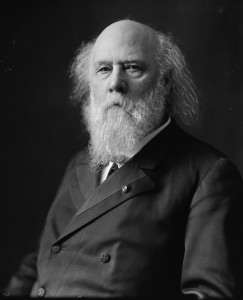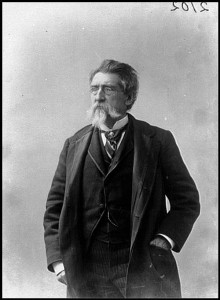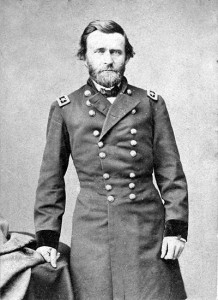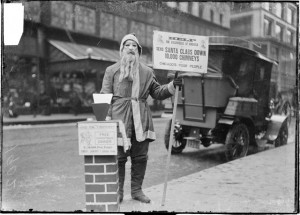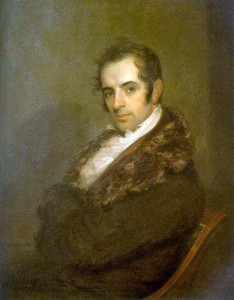
"The button affixed to the bosom of her dress attracted his attention and she made no opposition when he plucked it away." (Image by Josef Peters.)
Three-year-old Brooklyn lad Thomas Madden told his impoverished parents that he swallowed a button and was in terrible pain. X-rays were inconclusive and doctors began to doubt his story, but the anguish persisted and the Maddens were worried sick. The next few weeks probably seemed like a year to them. Two excerpts from the Brooklyn Daily Eagle below tell the story. (The New York Times was also on the case.)
••••••••••
“Search For A Button Which Young Madden Is Said to Have Swallowed,” Brooklyn Daily Eagle (January 18, 1897): “Little Thomas Josef Madden, 3 1/2 years old, whose parents live at 54 State street, will go under the X-ray, at the Hudson street hospital in New York again to-day. He was there yesterday and the father says the ray revealed the motto button, from a package of cigarettes, which the boy claims to have swallowed, lodged in the larger intestine, on the left side of the body, with the pin attached to the button sticking upward. Mr. Madden saw this himself, he says, and the doctors assured that it was so. The ray was not powerful enough, however, and it was decided to make a second examination this afternoon, using more effective apparatus. Meanwhile the child will continue abstinence from solid food and will continue the milk diet which he has had for two weeks since he has swallowed the button.

"The X-ray photograph taken yesterday revealed no indication of the presence of the button in the pyloric region." (Image by Steven Fruitsmaak.)
When the accident occurred he was a chubby little fellow with an exuberance of spirits, which made him the life of the humble household in which he lives. His father, who works along shore, and is a man of slender means, has viewed with increasing anxiety his little son’s rapid loss of flesh and the spasms of pain with which he is seized at home.
Mr. Madden said to-day that he had gone so far as to pawn some of his clothes to secure money with which to have the boy treated, and, he added, that as long as his resources were exhausted he did not know what to do now.
Superintendent Knoll of the Hudson street hospital is represented as having said that the X-ray photograph taken yesterday revealed no indication of the presence of the button in the pyloric region which was examined, but the boy’s father is very positive in the statement that the button was found.
Nobody saw the button swallowed, but all the members of the boy’s family are well satisfied that it is this which has caused all his suffering. Thomas Josef was sitting on the lap of Mrs. McGrath, a neighbor who was visiting the Maddens, and with whom the boy is a great favorite. The button affixed to the bosom of her dress attracted his attention and she made no opposition when he plucked it away. A few minutes later, when he was seated at the dinner table, Thomas was seized with a fit of choking. His father slapped him vigorously on the back and presently the child seemed relieved.
‘He just bolted on a piece of meat, papa,’ suggested Mrs. Madden.
‘Oh, no, mamma,’ spoke up the child, ‘it was that button.’
‘If I had known it was the button,’ said Mr. Madden, ‘I’d have had my finger down his throat in a minute. Now, I don’t know what to do.’
All the neighbors are very much excited over the case. The Maddens live in a tenement section.
••••••••••

"The emblem on it was an Irish flag. "
“Cut Out the Button: Tommy Madden Undergoes Successful Surgery,” Brooklyn Daily Eagle (January 24, 1897): “An interesting operation was performed in Post Graduate hospital in New York yesterday afternoon, when the physicians cut a cigarette button from the throat of little Thomas Madden. The boy swallowed the button a week ago, and it stuck in his throat and all efforts to dislodge it and extract it were until yesterday without effect. The operation yesterday was performed by House Surgeon Bullard and the regular house staff. When the button was cut from the throat it was found to be of the sort now placed in boxes of cigarettes. The emblem on it was an Irish flag. It was thought last night that the boy would recover.
The operation was long and tedious and occupied about three quarters of an hour. Before making the incision the surgeon made a careful attempt to remove the button through the mouth by forcing long, curved forceps down the throat. This proved impracticable.
Dr. Lee, who has charge of the ward at the Post Graduate hospital in which the little patient is confined, is very hopeful of Tommy’s ultimate recovery.”







